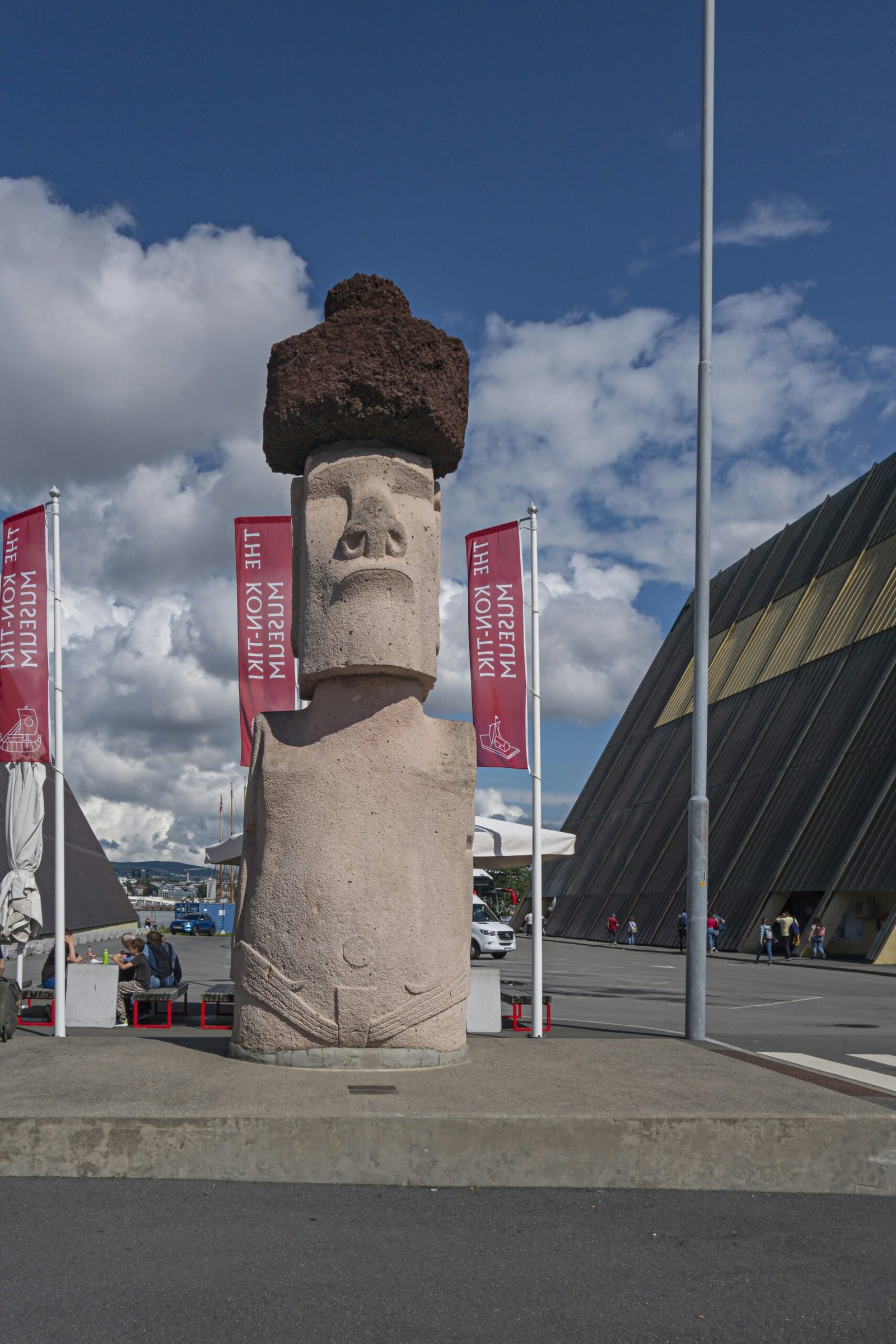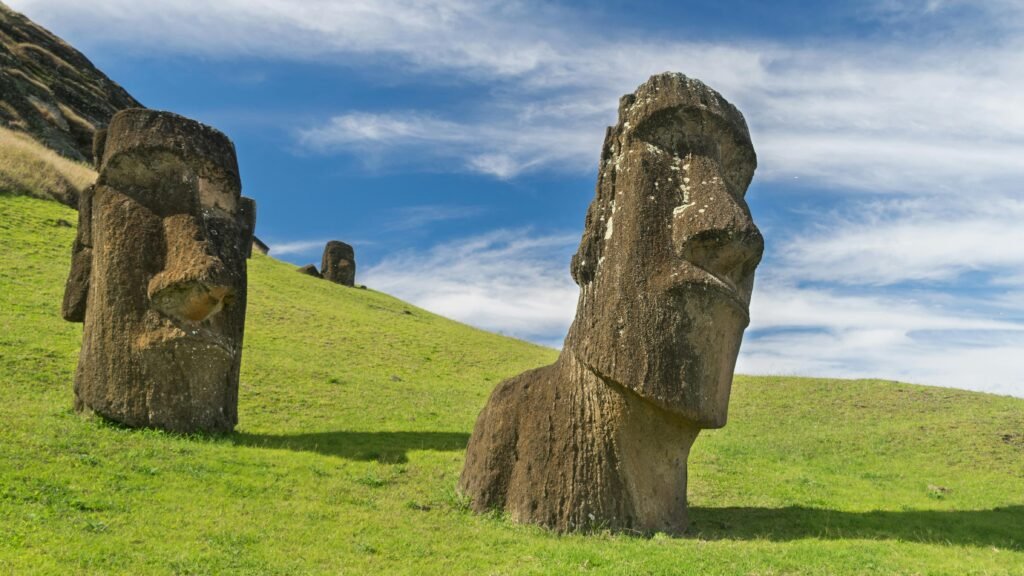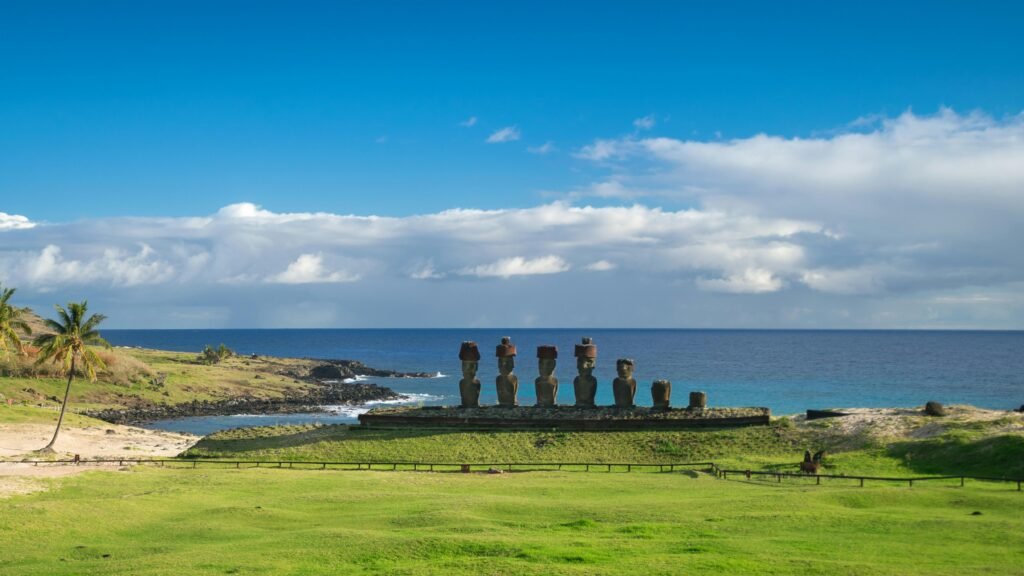Introduction to Easter Island
Easter Island, known as Rapa Nui in the indigenous language, is a remote volcanic island located in the southeastern Pacific Ocean. It is famous for its stunning landscapes and the extraordinary moai statues, which captivate the imagination of tourists and historians alike. The island was first discovered by Europeans on Easter Sunday in 1722, hence its popular name. This uninhabited land at the time was soon colonized by Polynesians who were believed to have arrived in canoes, bringing with them their customs and agricultural practices.

The Rapa Nui civilization flourished for centuries, marked by remarkable advancements in agriculture, architecture, and social organization. The islanders constructed the iconic moai statues, which symbolize their ancestral leaders and are intricately linked to their religious beliefs and societal structure. These statues serve not only as cultural emblems but also demonstrate the ingenuity and determination of the Rapa Nui people, who carved and transported these immense structures across the island.
The Mystical Moai Statues
The moai statues are perhaps the most iconic representation of Easter Island, known locally as Rapa Nui. These monolithic sculptures, primarily carved from volcanic tuff found on the island, stand as a testament to the ingenuity and skill of the Rapa Nui people. Predating the European arrival in the 18th century, it is believed that the construction of these statues occurred in several phases, with some dating as far back as 1400 AD. The sheer size of the moai, which can weigh upwards of 80 tons and reach heights of 30 feet, showcases not only the artistic ambition of the island’s past inhabitants but also their complex social structures.

Historically, the moai were created as representations of powerful ancestors, intended to be both ceremonial and functional. The positioning of the statues, often on stone platforms called “ahu,” aligns with significant astronomical events, underscoring the Rapa Nui’s sophisticated knowledge of their environment. The methods employed in transporting these statues are still a subject of extensive research and debate. Various theories suggest the use of a unique rocking mechanism which allowed teams of workers to move moai across the rugged terrain or the creation of sledges. Recent studies have illuminated the communal effort required, highlighting the cooperative spirit of the Rapa Nui society during this period.
Today, the moai continue to hold immense cultural significance for the Rapa Nui people. They serve as a reminder of their ancestral connections and cultural heritage. The statues have also become a focal point for tourism, drawing countless visitors eager to witness these marvels firsthand. This interaction between the local community and tourists has led to a renewed appreciation for the moai, sparking ongoing efforts for their preservation and the revitalization of Rapa Nui culture. Understanding the significance of the moai enhances the visitor experience, providing a deeper insight into the rich history and traditions that define this remote island in the Pacific Ocean.
Key Tourist Destinations: Rano Raraku
Rano Raraku is a crucial highlight of Easter Island, also known as Rapa Nui, renowned as the primary quarry site from which the island’s iconic moai were carved. This volcanic site, formed by a massive crater, not only boasts breathtaking natural landscapes but also serves as a living testament to the ingenuity of the Rapa Nui people. The geological features surrounding Rano Raraku are striking, characterized by steep volcanic slopes and lush vegetation that offers a unique backdrop for both exploration and photography.
As visitors arrive at Rano Raraku, they are greeted by the sight of nearly 400 moai still in various stages of completion, providing a direct insight into the historical significance of these monumental statues. The largest moai ever created, measuring over 21 meters, is located here, and many unfinished figures lie half-embedded in the quarry walls, showcasing the intricate carving techniques employed by the ancient sculptors. This multitude of carvings allows tourists to appreciate not only the scale of the moai production but also the artistic and cultural importance of these statues to the Rapa Nui civilization.
Moreover, Rano Raraku offers an exciting array of exploration opportunities. Visitors can embark on guided tours that delve into the fascinating history of the site, exploring the intricacies of moai creation and their roles in the Rapa Nui society. For photography enthusiasts, the dramatic volcanic landscapes combined with the presence of the moai creates countless captivating photographic opportunities, particularly during sunrise and sunset. With its combination of enduring history, geological marvels, and picturesque scenery, Rano Raraku is an essential destination for anyone seeking to understand the rich cultural tapestry of Easter Island.

AHU Tongariki: The Majestic Platform
Ahu Tongariki, the largest ceremonial site on Easter Island, Rapa Nui, stands as a testament to the island’s rich cultural heritage. Spanning approximately 200 meters in length, this impressive platform features a total of 15 moai statues, each intricately carved from volcanic tuff. These statues, believed to represent ancestral figures, were erected by the Rapa Nui people as symbols of authority and commemoration. The scale and design of Ahu Tongariki highlight not only the advanced craftsmanship of the island’s ancient inhabitants but also their profound spiritual beliefs.
The history of Ahu Tongariki dates back to the 15th century, when it served as a significant ceremonial site. However, over the centuries, it fell into disrepair due to natural disasters and the impact of colonial activities. The 1960 tsunami caused extensive damage to the site, leading to a state of neglect. In response to the deteriorating condition of Ahu Tongariki, restoration efforts began in the late 20th century. Funded by both international organizations and local initiatives, the restoration project aimed to reposition the moai on their platforms and preserve the integrity of this cultural landmark. Today, visitors can appreciate the results of this dedication, which not only restored the site but also helped to rekindle a sense of pride within the Rapa Nui community.
One of the highlights of Ahu Tongariki is the breathtaking views it offers, especially during sunrise and sunset. The sight of the sun rising behind the towering moai or setting against the ocean offers a profoundly serene experience that captivates visitors. Photographers and nature enthusiasts flock to the site to capture the awe-inspiring scenery, while history buffs delve into the stories of the moai and their significance. A visit to Ahu Tongariki is an essential part of any touristic journey to Easter Island, providing insights into both the ancient culture of Rapa Nui and the beauty of its natural environment.
Anakena Beach: A Tropical Paradise
Anakena Beach, located on the northern coast of Easter Island, is often revered as one of the most picturesque locations on Rapa Nui. Characterized by its soft white sands, crystal-clear turquoise waters, and swaying palm trees, the beach offers a perfect blend of natural beauty and historical significance. Surrounded by an idyllic landscape, Anakena serves not only as a location for relaxation and leisure but also as a site deeply embedded in the cultural heritage of the island.
Historically, Anakena Beach holds a prominent place in Rapa Nui lore. It is believed to be the landing site of Hotu Matu’a, the island’s legendary first king. The presence of several moai statues at this beach further enhances its historical allure, as they stand as silent witnesses to the rich past of the Rapa Nui culture. These monumental carvings embody the artistry and spiritual beliefs of the island’s inhabitants, making Anakena a vital part of their heritage.
For visitors seeking leisure activities, Anakena Beach offers an array of options. Swimming and sunbathing are popular pastimes, with the shallow waters providing a safe environment for families and individuals alike. The beach’s warm climate and gentle waves create ideal conditions for relaxation or a leisurely swim. Furthermore, beachgoers can engage in snorkeling to explore the vibrant marine life within the surrounding waters. Local vendors offer refreshments, enhancing the experience with tropical drinks and traditional Rapa Nui cuisine.
In addition to its recreational offerings, the beach’s serene ambiance makes it a perfect setting for cultural gatherings and celebrations. Visitors often find themselves captivated by the legends that permeate the area, further enriching their experience. Thus, Anakena Beach remains not only a destination for relaxation but also a gateway to understanding the enchanting mysteries of Rapa Nui.
Outdoor Adventures: Hiking and Snorkeling
Easter Island, known as Rapa Nui, is a destination rich with natural beauty and adventure opportunities that beckon outdoor enthusiasts. The island offers a range of hiking trails that provide breathtaking views and come with the added bonus of exploring volcanic craters. A prime example is the hike to the Rano Kau crater, which is not only a geological wonder but also provides panoramic vistas that showcase the island’s rugged terrain and lush landscapes. The path leads through diverse ecosystems, where hikers may encounter native flora and fauna unique to the region.
Another notable trail is the one that leads to the iconic Tufu Rock, which offers a unique perspective on the island’s geological features while also providing a visual feast of the surrounding coastline. These hiking experiences vary from leisurely walks to more challenging treks, catering to all fitness levels and interests. Whether you seek a peaceful stroll or an invigorating hike, the trails of Rapa Nui cater to a variety of outdoor adventurers.
In addition to hiking, Easter Island is also a prime location for snorkeling, thanks to its crystal-clear waters and thriving marine life. The coral gardens and underwater cliffs around the island are home to vibrant fish species, sea turtles, and other remarkable marine creatures. Popular snorkeling spots such as Anakena Beach and the waters surrounding Motu Nui offer the perfect conditions for both novice and experienced snorkelers to explore the enchanting underwater landscapes. The experience of swimming alongside colorful schools of fish and observing the diverse coral formations creates an unforgettable adventure.
Outdoor exploration on Easter Island is a captivating way to engage with the island’s natural beauty. From hiking the volcanic landscapes to snorkeling in the pristine waters, visitors can immerse themselves in experiences that highlight Ecuador’s unique offerings. These adventures provide not only physical activity but also a deeper appreciation for the island’s rich cultural and ecological heritage.
Cultural Significance: Engaging with the Rapa Nui Community
Tourism on Easter Island, known as Rapa Nui, plays a vital role in preserving the unique culture and traditions of the local community. Engaging with the Rapa Nui people provides visitors with a deeper understanding of their customs, beliefs, and way of life. More than just a destination, Easter Island is a living tapestry of cultural heritage, where interactions with the community can enrich the overall experience of any traveler.
Participating in culturally significant events and traditional ceremonies allows tourists to witness the vibrant expressions of Rapa Nui culture. Festivals, such as Tapati Rapa Nui, offer an opportunity to observe and partake in traditional dances, music, and sporting activities that have been cherished for generations. Attending these events not only creates memorable experiences for visitors but also supports the local community by promoting their traditions and enhancing cultural pride.
Moreover, engaging with local artisans presents a meaningful way to appreciate Rapa Nui’s craftsmanship while contributing to the economy of the island. From the intricate carvings of wood to the beautiful textiles, these artisans reflect the spirit of their ancestors through their creations. Purchasing local crafts helps sustain the artisans and ensures the continued existence of Rapa Nui’s artistic heritage. By investing in local products, tourists assist in the preservation of cultural practices that could otherwise be lost in a rapidly changing world.
Lastly, respectful engagement with the Rapa Nui community fosters connections that are often transformative. It encourages an exchange of knowledge and fosters mutual respect between visitors and locals. Understanding the importance of cultural significance and participating in the preservation efforts through responsible tourism can create a lasting legacy for future generations. By valuing and supporting the Rapa Nui people, tourists contribute to the preservation of a culturally rich and historically significant destination.
Travel Tips: Navigating Easter Island
Easter Island, known as Rapa Nui, is a unique destination that attracts travelers with its captivating history and stunning landscapes. To ensure a smooth and enjoyable trip, it is essential to plan ahead and consider several travel tips. The best times to visit Easter Island are during the shoulder seasons of spring (September to November) and fall (April to June), when the weather is milder, and tourist crowds are smaller. Summer months can be quite busy due to holidays, while winter may bring some rainfall.
Transportation options on the island are limited but manageable. The most effective way to explore is by renting a vehicle, which allows for maximum flexibility in visiting sites at your own pace. Several rental agencies operate on the island, providing options such as cars, scooters, and bicycles. Local buses also serve some major tourist attractions, but they may not run as frequently. Thus, planning your excursions around the bus schedules is advisable.
When it comes to accommodation, travelers can find a variety of options ranging from family-run guesthouses to more upscale hotels. Booking in advance, especially during peak season, is recommended to secure your preferred stay. Many accommodations offer breakfast and can assist with arranging tours, thereby enhancing the overall experience. Make sure to inquire about any packages that combine lodging with guided visits to popular sites, such as the Moai statues or volcanic craters.
Overall, understanding these travel tips will help you navigate Easter Island more effectively, allowing you to immerse yourself in its rich culture and history while enjoying the natural beauty of Rapa Nui. By preparing ahead and remaining flexible, visitors can maximize their experience on this fascinating island.
Culinary Experiences: Sampling Local Cuisine
When visiting Easter Island, known locally as Rapa Nui, immersing oneself in the island’s culinary landscape is an essential component of the experience. The traditional cuisine of Rapa Nui is a delightful reflection of the island’s rich cultural heritage and its unique geographical context. The food culture here is heavily influenced by the island’s Polynesian roots, utilizing the bounty of both land and sea. Seafood takes a prominent position, with dishes often featuring freshly caught fish such as mahi-mahi, tuna, and marinated octopus.
One of the staples of Rapa Nui cuisine is ‘curanto,’ a traditional dish that combines various meats and seafood, all cooked in an underground oven with aromatic leaves. The flavors are enhanced by the unique volcanic soil, enriching the ingredients with a distinct taste. Another popular dish is ‘po’e,’ a dessert made from mashed bananas mixed with sweet potato or pumpkin, often enjoyed during festivities. Local restaurants may also serve ’emapa,’ a type of sweet potato bread that has been enjoyed for generations.
For those seeking an authentic dining experience, a few must-visit establishments include the popular ‘Te Moana,’ which offers dishes inspired by traditional Rapa Nui flavors, and ‘La Kaleta,’ famous for its fresh seafood and tranquil ocean views. Known for providing a welcoming atmosphere, these restaurants often feature local culinary art and crafts, offering tourists a deeper insight into the vibrant culture of Rapa Nui. Additionally, engaging with local chefs can provide visitors with valuable knowledge about the significant role food plays in Rapa Nui society, from communal gatherings to celebration ceremonies.
Sampling the local cuisine on Easter Island is not merely about tasting food; it is about savoring the stories and traditions that come with each dish. This culinary journey through Rapa Nui will undoubtedly enrich any travel experience, leaving lasting memories of not just the flavors but the cultural significance behind them.



